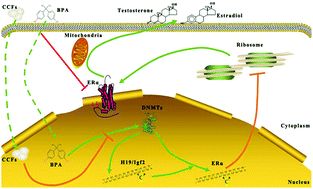当前位置:
X-MOL 学术
›
Food Funct.
›
论文详情
Our official English website, www.x-mol.net, welcomes your feedback! (Note: you will need to create a separate account there.)
Cuscuta chinensis flavonoids down-regulate the DNA methylation of the H19/Igf2 imprinted control region and estrogen receptor alpha promoter of the testis in bisphenol A exposed mouse offspring.
Food & Function ( IF 6.1 ) Pub Date : 2020-01-13 , DOI: 10.1039/c9fo02770j Yuanyuan Wei 1 , Chao Han , Shuying Li , Yuqing Cui , Yongzhan Bao , Wanyu Shi
Food & Function ( IF 6.1 ) Pub Date : 2020-01-13 , DOI: 10.1039/c9fo02770j Yuanyuan Wei 1 , Chao Han , Shuying Li , Yuqing Cui , Yongzhan Bao , Wanyu Shi
Affiliation

|
Exposure to the emerging contaminant bisphenol A (BPA) is ubiquitous and associated with reproductive disorders. The BPA effect as an endocrine disruptor is widely known but other mechanisms underlying developmental disease, such as epigenetic modifications, still remain unclear. The objective of this study was to investigate whether Cuscuta chinensis flavonoids (CCFs) can be used as a dietary supplement to reverse BPA-induced epigenetic disorders, by analyzing the molecular processes related to BPA impairment of testicular development. BPA and different concentrations of CCFs were administered to the dams at gestation day (GD) 0.5-17.5. The testis and serum of male mice were collected at postnatal day (PND) 21 and PND 56 for the detection of related indicators. Our results showed that compared with the BPA group, CCFs could significantly increase the serum contents of testosterone (T), estradiol (E2) in males at PND 21 and PND 56, as well as the contents and transcription levels of DNA methyltransferase 3A (Dnmt3A), Dnmt3B in males at PND 21 and that of estrogen receptor alpha (ERα) at PND 56. The expressions of Dnmt1 and ERα at PND 21 and ERβ at both PND 21 and PND 56 in males were significantly decreased with the administration of different concentrations of CCFs (P < 0.01 or P < 0.05). CCFs also significantly inhibited the BPA-induced hypermethylated status of the ERα promoter and H19/Igf2 imprinting control region (ICR) in the testis at PND 56. These results indicated that CCFs could decrease the methylation levels of ERα and H19/Igf2 genes by inhibiting the expression of DNA methyltransferases (DNMTs), thereby decreasing the levels of reproductive hormones and receptors in adult males, and ultimately alleviating the negative effect of BPA on testicular development in male mice.
中文翻译:

菟丝子黄酮类化合物下调双酚 A 暴露小鼠后代睾丸 H19/Igf2 印迹控制区和雌激素受体 α 启动子的 DNA 甲基化。
接触新出现的污染物双酚 A (BPA) 无处不在,并与生殖障碍有关。BPA 作为内分泌干扰物的作用广为人知,但发育疾病的其他机制,如表观遗传修饰,仍不清楚。本研究的目的是通过分析与 BPA 损害睾丸发育相关的分子过程,研究菟丝子黄酮类化合物 (CCF) 是否可用作膳食补充剂来逆转 BPA 诱导的表观遗传疾病。在妊娠日 (GD) 0.5-17.5 时,将双酚 A 和不同浓度的 CCF 施用于水坝。在出生后第21天和第56天收集雄性小鼠的睾丸和血清,用于检测相关指标。我们的结果表明,与 BPA 组相比,CCFs可以显着增加PND 21和PND 56男性血清睾酮(T)、雌二醇(E2)的含量,以及PND 21男性DNA甲基转移酶3A(Dnmt3A)、Dnmt3B的含量和转录水平,雌激素受体α(ERα)在PND 56的表达。男性PND 21的Dnmt1和ERα以及PND 21和PND 56的ERβ的表达随着施用不同浓度的CCFs而显着降低(P < 0.01或P < 0.05 )。CCFs 还显着抑制了 BPA 诱导的 ERα 启动子和 H19/Igf2 印记控制区 (ICR) 在 PND 56 的睾丸中的高甲基化状态。这些结果表明 CCFs 可以通过抑制 ERα 和 H19/Igf2 基因的甲基化水平降低DNA甲基转移酶(DNMT)的表达,
更新日期:2020-02-13
中文翻译:

菟丝子黄酮类化合物下调双酚 A 暴露小鼠后代睾丸 H19/Igf2 印迹控制区和雌激素受体 α 启动子的 DNA 甲基化。
接触新出现的污染物双酚 A (BPA) 无处不在,并与生殖障碍有关。BPA 作为内分泌干扰物的作用广为人知,但发育疾病的其他机制,如表观遗传修饰,仍不清楚。本研究的目的是通过分析与 BPA 损害睾丸发育相关的分子过程,研究菟丝子黄酮类化合物 (CCF) 是否可用作膳食补充剂来逆转 BPA 诱导的表观遗传疾病。在妊娠日 (GD) 0.5-17.5 时,将双酚 A 和不同浓度的 CCF 施用于水坝。在出生后第21天和第56天收集雄性小鼠的睾丸和血清,用于检测相关指标。我们的结果表明,与 BPA 组相比,CCFs可以显着增加PND 21和PND 56男性血清睾酮(T)、雌二醇(E2)的含量,以及PND 21男性DNA甲基转移酶3A(Dnmt3A)、Dnmt3B的含量和转录水平,雌激素受体α(ERα)在PND 56的表达。男性PND 21的Dnmt1和ERα以及PND 21和PND 56的ERβ的表达随着施用不同浓度的CCFs而显着降低(P < 0.01或P < 0.05 )。CCFs 还显着抑制了 BPA 诱导的 ERα 启动子和 H19/Igf2 印记控制区 (ICR) 在 PND 56 的睾丸中的高甲基化状态。这些结果表明 CCFs 可以通过抑制 ERα 和 H19/Igf2 基因的甲基化水平降低DNA甲基转移酶(DNMT)的表达,


























 京公网安备 11010802027423号
京公网安备 11010802027423号